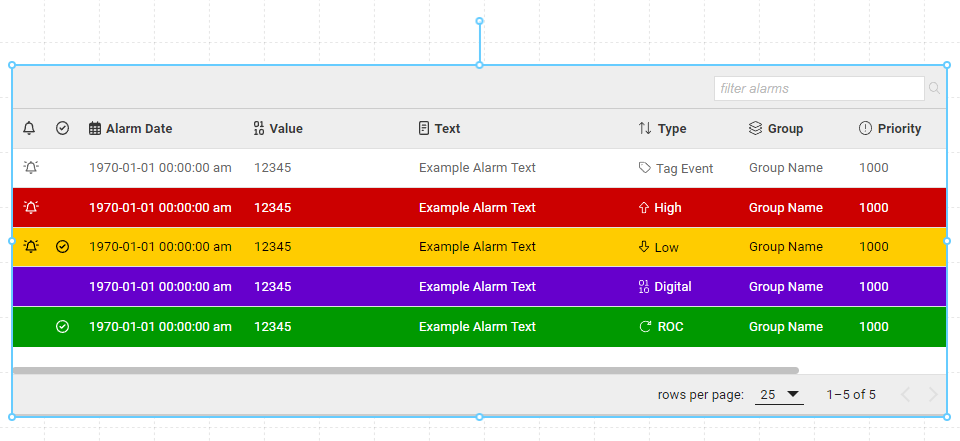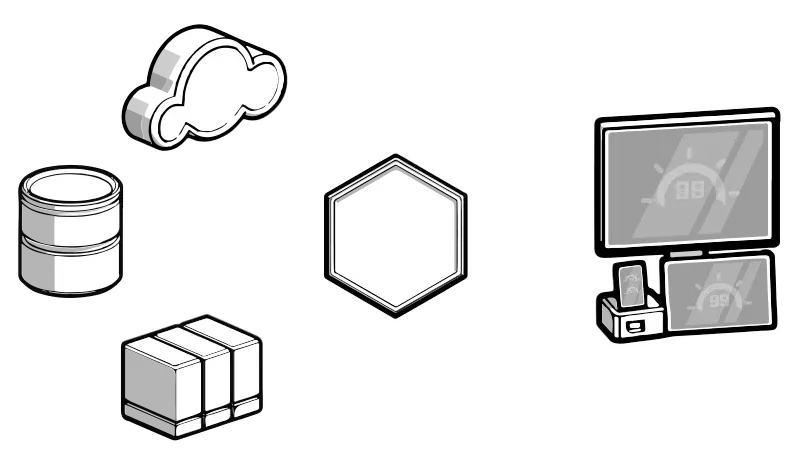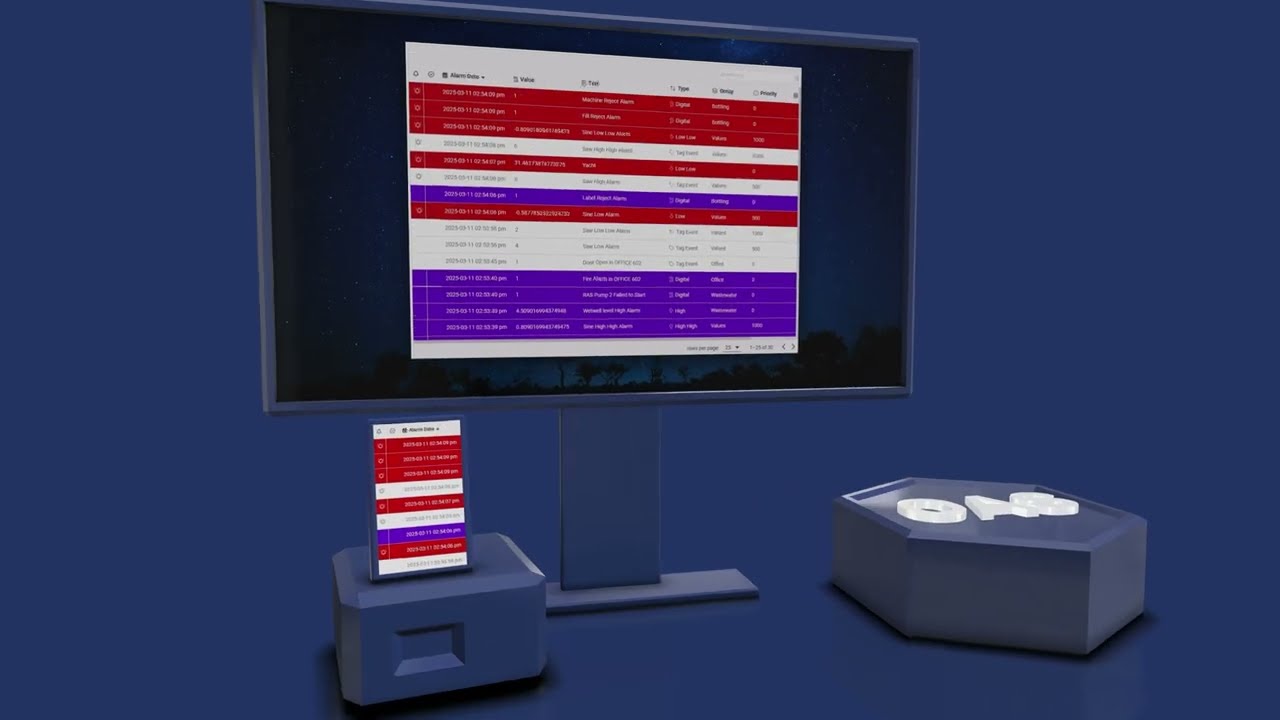Add Real Time and Historical Alarms to Your Web Apps
OAS Web Alarm integrates with existing web applications as well as new applications built on any number of front-end frameworks. Whether you work in vanilla HTML and Javascript, or utilize a front end web development platform. Web Alarm displays real time and historical alarm data in an interactive or animated graphical format on any device with a web browser.
a server-based, highly-scalable, network platform that enables the transport and transformation of your data
Data HistorianAchieve fault-tolerant logging, zero data loss, and multi-destination storage with our high-performance Store and Forward technology.
Visualization ToolsBuild Visualizations, User Interfaces, and server configuration interfaces for .NET, web technologies, native iOS and Android mobile apps
Device & Data ConnectorsThe OAS Platform provides rapid communications and connectivity to a wide variety of PLCs, devices, and databases.
IoT ConnectorsConnect to cloud-base IoT gateways such as AWS, Azure IoT Hub, Azure Event Hubs, Kafka, and more.
Alarm Logging & NotificationCapture events on each data point, log to open formats for historical analysis and archiving, and trigger real time notifications
SDKs & APIsExplore a wide variety of Developer Tools and APIs to allow you to create applications and system integrations to execute in any environment.
Networking FeaturesOpen Automation Software implements edge computing with a Distributed Network Architecture.
Download a fully functional trial of Open Automation SoftwareKey Features & Benefits
Browser Compatibility
Works with all modern browsers on any device, PC, Mac, Android, iOS, mobile, tablets, MS Edge, Chrome, Safari, and more. Web HMI is built on universally implemented browser standards such as HTML, Javascript, and CSS. No additional installation or plugins required.
Use with Existing Frameworks
Because Web Alarm uses standard HTML and Javascript, you can integrate it within your own custom application, or add behaviors to another framework like ASP.NET, Ruby on Rails, PHP, Angular, React and VueJS.
Security
All client to server communications can be locked down using SSL. Simply enable SSL in the OAS server and data is encrypted over the wire between the browser and OAS.
Direct Data Delivery
All OAS data is directly sent and received between the client and the OAS server, which eliminates the need to implement server-side handling, and removing load from your web application server.
Using Web Alarm
Configuration Syntax
Within your web application code, you defined the configuration of the Web Alarm data feed, including how to filter Alarms, display options, and more. You can optionally integrate with Javascript events for custom handling of user inputs.

Looking for a No-Code Solution?
The OAS Open UIEngine is perfect for rapid development when you want to build simple or complex applications but do not have the resources for custom web development. UIEngine is a complete web-based application development tool and no code solution for HMI / SCADA using an intuitive drag and drop interface. UIEngine also has a robust Alarm Component that allows you to display real time and historical Alarms with zero code.

Common Questions
What skills are necessary to use Web Alarm?
Web Alarm is based on web development standards like HTML and Javascript. It can be integrated into virtually any web application front-end platform by developers able to craft basic web pages.
Can the Web Alarm appearance be customized?
Yes, you can configure the color scheme using CSS, and set filters for alarm data based on priority, alarm state, alarm type, and more.
Learn how thousands of customers are using the OAS Product Platform around the globe to achieve truly open industrial automation
24/7/365
Support
Technical support available by phone, chat, and email
30+ Years
Experience
Product efficacy, market testing, and reliability
Used in 10K+
Data Servers
OAS is used in thousands of businesses worldwide
OAS Platform Features
Cross-Platform Support
The OAS Platform supports multiple operating systems and deployment options including Windows, Linux, Docker Containers, and can even run on low footprint devices such as a Raspberry PI 4.
Networking
OAS is an edge solution that offers flexible networking options for standalone installations, multi-tenant data aggregation, and even secure unidirectional data transport.
Programmatic Setup
Utilize our .NET SDK or REST API for flexible and automated setup, ensuring full integration with your asset management software. You can also import and export CSV files, which helps you work with Excel and third-party applications.
Calculations, Time On, Counts, and Totals
Merge data from various controllers and additional data sources while performing real-time computations and logic processing, all without the need for coding. Monitor the duration of activities for specific points and the frequency of their transitions over a defined period. Aggregate analog values both daily and over the entire timeline.
See How We Compare
The initial cost of OAS is far less than our competitors – but the savings don’t stop there. We work with OEMS and System Integrators to provide perpetual licenses with quantity discounts with flexible tag pricing and unlimited client connections.
No Question Left Unanswered
We make getting started with OAS easy - Browse our extensive Knowledge Base of articles on Getting Started as well as How To content that takes you step-by-step through building a solution, and finally learn more about specific features and configurations.
Getting Started - Download, Setup & Support
Step-by-step introduction to using the Open Automation Software platform
How to manually add and define Tags using the Configure OAS application.
Familiarize yourself with OAS Alarms and Tag configuration.
Learn how to set up and use Web Alarm in your web applications.
Learn about programmatically configuring Web Alarm.
More about the 3 key networking methods included with licenses.
How to quickly access options and make custom changes.
How to active and manage OAS license.





